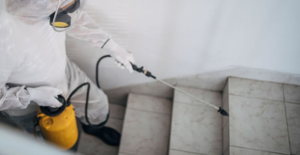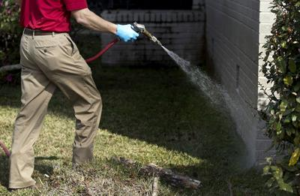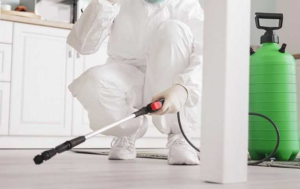Pest Control Allen TX includes prevention – keeping pests from entering a property, suppression – reducing a pest population to an acceptable level, and eradication – eliminating the pests. It also involves inspection, identifying and correcting conditions that support pest populations such as food, water and shelter.
Physical pest control techniques include traps, baits, and crack and crevice treatments. It may also involve introducing natural predators and parasites or using chemicals such as pheromones or juvenile hormones.

Pests do more than just spoil the appearance of a building or garden. They can also introduce harmful germs and diseases, posing serious health risks for people and pets. That’s why it’s important to take steps to prevent pests before they invade your space.
The best way to keep pests at bay is by keeping their food, water and shelter sources far away from your property. In order to do this, you need to regularly clean and sanitize your house. This includes not only wiping down counters, but also getting rid of dirty dishes and utensils that can attract pests. Mattresses, pillows and rugs should be regularly washed or vacuumed as well. Clutter should be removed and stored items kept in tightly closed containers. In addition, it’s essential to regularly caulk cracks and crevices around cabinets, baseboards and walls to keep pests from entering your space.
While preventing pests requires consistent effort, there are some factors that can’t be controlled. Natural forces that affect pests include climate, natural enemies, natural barriers, and the availability of food and water. These factors can either help or hinder pest control efforts.
A lot of pests, such as cockroaches, require water to regulate their bodies. Regularly cleaning sinks and drains can help to reduce their number. It’s also important to properly dispose of waste and keep garbage cans tightly sealed. Keeping plants and trees trimmed and away from buildings can also be helpful in reducing pests.
In some cases, the use of pesticides may be necessary in order to stop a pest infestation problem. However, the correct application of these chemicals is very important. Only licensed professionals can safely and correctly use pesticides to avoid the risk of harming children or pets. It’s essential to read and follow all instructions, warnings and safety precautions when using pesticides. Also, only use the correct pesticide type for the specific pest. For example, a spray pesticide is not suitable for controlling rodents as it would be sprayed over the entire space where they can hide. Instead, a trap or bait for rodents should be used.
Suppression
Pests are a major problem for many gardeners and property owners. They damage plants, food, and building materials. They also carry diseases that can cause human illness. Managing pest populations by preventive, suppression and eradication methods is essential to ensuring that they do not cause unacceptable harm. Preventive measures include eliminating conditions that promote pest establishment, removing pests from buildings and landscapes, and quickly acting to restrict the growth of existing pest infestations. Eradication methods, such as fumigation and spraying, are used to remove pests from buildings, landscapes, or entire areas.
The most important step in pest control is to eliminate conditions that encourage their establishment. For example, storing food in containers that close tightly and keeping garbage cans closed reduces pest problems. Regularly removing garbage from home, retail or hospitality settings reduces rodent numbers and the spread of their droppings that can carry disease. Blocking holes in the wall or foundation of a home to stop the entrance of insects and rodents can limit these pest problems, as well.
Other pest-control techniques include reducing the availability of food or water to a target pest, and providing a barrier that prevents or restricts pest access to the food source or other resources. Biological controls can be useful in these cases, as well. Natural enemies of insects, including predators, parasitoids, and pathogens, can control insect populations when their populations are not devastated by pesticides. Classically, these natural enemies are bred in the laboratory and then released into the environment, where they can breed and provide long-term control of the pest.
Another form of biological control involves plant-infecting pathogens. These are fungi that can infect and kill plants and, in some cases, insects. They are often applied as a liquid or powder and can be used to control weeds, plant-parasitic nematodes, and insect pests.
scouting and monitoring pests is another key part of preventing and controlling pest problems. Scouting is the act of regularly searching for and observing pests. It is important to understand the limits of threshold-based decision making, which is that a pest should be controlled only when its population grows to an unacceptable level.
Detection
While preventing infestations is the primary goal of pest control, the reality is that many pest problems develop gradually and may go unnoticed until the problem reaches an unmanageable size. In such cases, a thorough inspection can identify the pest infestation before it becomes severe and leads to property damage, health risks, or other serious problems.
In residential settings, frequent or increased sightings of cockroaches, ants, rodents, and other pests around the house is usually one of the first clear signs of a pest problem. In addition to visual evidence, scurrying sounds in the walls or ceilings and odors can also indicate pest presence. Taking the time to regularly sweep and vacuum, and to clean up spills and food debris, can help prevent the buildup of grime that attracts pests.
Other visible signs of pests include droppings, soiled fabrics, shredded paper or other materials, and damaged wood or fabric. It’s important to inspect hard-to-reach areas like inside cabinets, pantries, crawl spaces and attics for pests. Also, many species of pests change physical appearance depending on their stage in life or the time of year-correct identification is key for management tactics to be effective.
Listening for signs of pest activity is another key way to detect pests. Scratching, scurrying and whining noises often indicate that pests are active in attics, basements or other areas of the home. Such noises are especially noticeable at night, when many rodents and insects are most active.
Finally, the presence of nests or hives within a structure or on its exterior is a direct indicator of a pest problem. Rodents, for example, frequently create nests from shredded paper or fabric and hide them in secluded spots. Bees and wasps build hives in attics or on the sides of homes. Finding these structures necessitates immediate action, as they typically indicate an established colony or swarm and may pose health risks for people or pets.
In commercial settings, a thorough inspection of the premises can uncover signs of pest infestation. It’s particularly important to inspect storage areas, kitchens and restrooms for rat droppings, soiled floors or fabric, and stains on walls. Regular decluttering and sweeping, as well as repairing leaks and installing dehumidifiers in damp areas, can make the premises less appealing to moisture-seeking pests.
Treatment
If pests are allowed to persist, they can cause significant damage to buildings and food supplies. They may also carry diseases, which can have serious or even life-threatening implications for people who come into contact with contaminated areas.
A variety of physical and chemical pest control methods are available to deal with specific problems. Physical methods include traps and barriers that exclude or capture pests. Chemical methods include aerosol sprays, dusts, baits, and gels that target specific pests by disrupting their nervous systems or killing them. Pesticides must be carefully selected and used, as they can harm beneficial insects and contaminate water runoff or other parts of the environment.
Certain microorganisms can be used to destroy pests without damaging humans, animals, or plants. The bacterium Bacillus thuringiensis, for example, produces a toxin that is harmful to caterpillars but not to other plants or animals. Other types of biological pest control include pathogens that cause disease in pests and parasites that live on or in pests.
The availability of food and water can limit pest populations, as can geographic features that restrict their movement or habitats. The presence of natural predators, such as birds and other mammals, can also affect pest population levels.
Many pests can cause structural damage, such as gnawing rodents that contaminate food, poisonous spiders, and scorpions that attack people. They can also spread disease through their fur, droppings, saliva, or feet.
Keeping garbage cans outside and putting food away promptly after each meal can help prevent infestations. The trash can should also be covered and sealed tightly, and it is a good idea to use large containers instead of small ones. Open trash cans feel like an all-you-can-eat buffet to pests, and they often enter the house looking for food in the contents. In addition, all perishable food should be kept in the fridge or in thick plastic containers. Pets are generally sensitive to pesticides and should be temporarily dropped off at a friend’s house during treatment.




